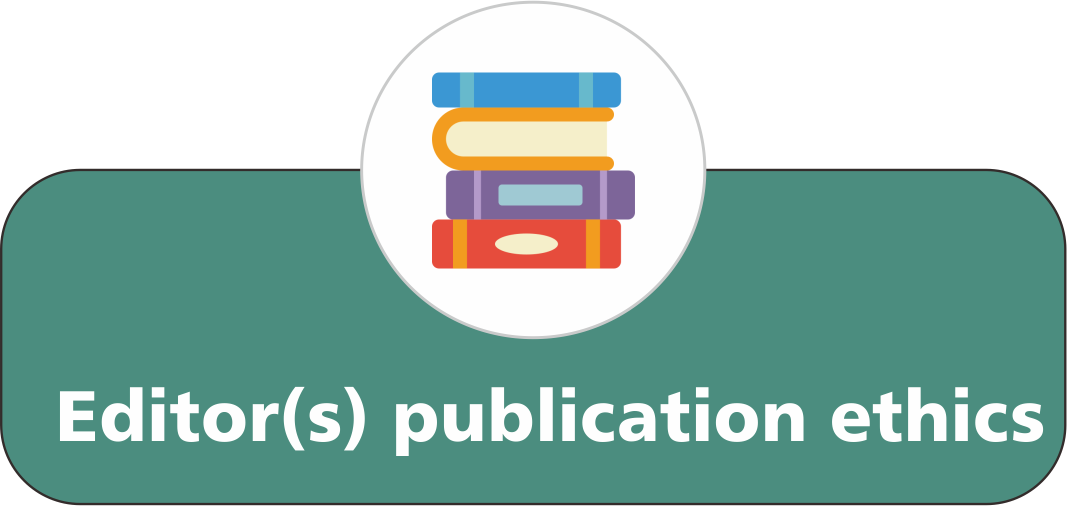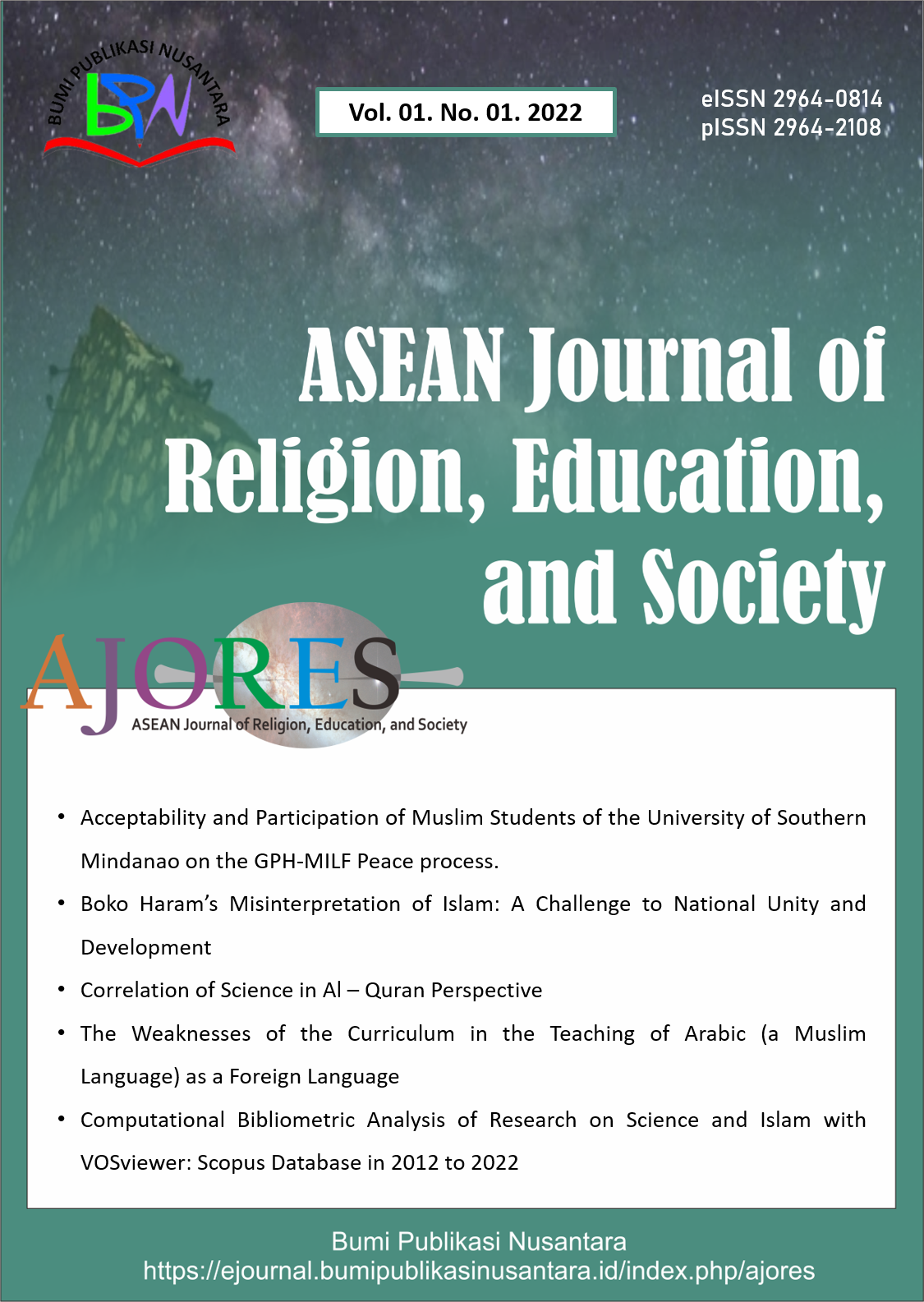The Role of Cultural Beliefs in Shaping Marital Practices: A Study of Mëranao Families
 ),
),
(1) Rufo dela Cruz Integrated School
 Corresponding Author
Corresponding Author
Abstract
Keywords
References
Abdullah, S.M. (2013). Negotiating tradition: The changing role of women in Mëranao marriages. Women's Studies International Forum, 36, 14-22.
Adeoye, M.A. (2023). Book review on soteriology: An African outlook (a historical study of the Christian doctrine of salvation from an African perspective). ASEAN Journal of Religion, Education, and Society, 1(1), 49-54.
Adeoye, M.A., Jimoh, H.A., and Abdulkareem, H.B. (2023). Leadership and organizational cultural roles in promoting sustainable performance appraisal and job satisfaction among academic staff. ASEAN Journal of Economic and Economic Education, 2(2), 115-124.
Ahsan, M., Uzair, M., and Ali, M. (2022). Attitudes and perceptions towards cultured meat among general population in Pakistan. ASEAN Journal of Science and Engineering Education, 2(1), 111-122.
Al Husaeni, D.F., and Al Husaeni, D.N. (2022). Computational bibliometric analysis of research on science and Islam with VOSviewer: Scopus database in 2012 to 2022. ASEAN Journal of Religion, Education, and Society, 1(1), 39-48.
Anggraeni, R., and Maryanti, R. (2021). Implementation of video learning media in Islamic Religious Education subjects. Indonesian Journal of Multidiciplinary Research, 1(2), 257-266.
Arciosa, R.M., Nim, M., Tagupa, L.M., Ogod, B., Dondoyano, L., Cogollo, M.L., and Hurtado, J.G. (2023). Folk dances and their impact on the Philippine culture-based education. Indonesian Journal of Multidiciplinary Research, 3(1), 107-116.
Azizah, S.N., Nandiyanto, A.B.D., Wulandary, V., and Irawan, A.R. (2022). Implementation of video learning media in Islamic religious education subjects for elementary school students. Indonesian Journal of Multidiciplinary Research, 2(1), 91-96.
Balo, G.S.C., Mama, R.A.D., Monteroso, A.I.B., Tsai, A E.T., and Veloso, D.T.M. (2022). Muslim modesty: Cultural reverberations of local predominant conventions towards the meaning-making of modesty among young adult muslimahs in Marawi and Manila, Philippines. Sinaya: A Philippine Journal for Senior High School Teachers and Students, 1(1), 5.
Boransing, A.M. (2012). Islamization, customary law, and the dynamics of Mëranao marital practices. Journal of Southeast Asian Studies, 43(2), 245-264.
Camral, K.A.M. (2022). Acceptability and participation of Muslim students of the University of Southern Mindanao on the GPH-MILF peace process. ASEAN Journal of Religion, Education, and Society, 1(1), 1-16.
Daalen, K.R.V., Kallesøe, S.S., Davey, F., Dada, S., Jung, L., Singh, L., Issa, R., Emilian, C.A., Kuhn, I., Keygnaert, I., and Nilsson, M. (2022). Extreme events and gender-based violence: a mixed-methods systematic review. The Lancet Planetary Health, 6(6), e504-e523.
Datukan, J.T. (2015). Mëranao traditional marriage customs: An ethnographic study. Philippine Journal of Anthropology, 18(1), 75-94.
De Guia, D.P. (2009). Marriage and the quest for Mëranao identity: A historical perspective. Philippine Quarterly of Culture and Society, 37(3/4), 218-239.
Guimba, A.H. (2010). Bridewealth negotiations and the economy of Mëranao marriages. Philippine Social Science Journal, 32(2), 89-108.
Herdian, K.D.P.H., and Maryanti, R. (2023). Titi Laras damina educational for senior high school student as a form of cultural preservation. Indonesian Journal of Educational Research and Technology, 3(3), 179-186.
Hirsch, C. (1996). Understanding the influence of gender role identity on the assumption of family caregiving roles by men. The International Journal of Aging and Human Development, 42(2), 103-121.
Jamieson, L. (2011). Intimacy as a concept: Explaining social change in the context of globalisation or another form of ethnocentricism?. Sociological Research Online, 16(4), 151-163.
Jamiu, I.M. (2022). Boko Haram’s misinterpretation of Islam: A challenge to national unity and development. ASEAN Journal of Religion, Education, and Society, 1(1), 17-24.
Jamiu, L.A. (2022). The weaknesses of the curriculum in the teaching of Arabic (a Muslim language) as a foreign language. ASEAN Journal of Religion, Education, and Society, 1(1), 31-38.
Jones, R. (2006). Polygyny in Islam. Macalester Islam Journal, 1(1), 11.
Levinger, G. (1976). A social psychological perspective on marital dissolution. Journal of Social Issues, 32(1), 21-47.
Loue, S. (2006). Multi-bonding: Polygamy, polygyny, polyamory. Sexual Partnering, Sexual Practices, and Health, 2, 27-53.
McLoyd, V.C., Cauce, A.M., Takeuchi, D., and Wilson, L. (2000). Marital processes and parental socialization in families of color: A decade review of research. Journal of Marriage and Family, 62(4), 1070-1093.
Millatina, S.N., Maryanti, R., and Wulandary, V. (2022). Strengthening literacy of cultural arts and crafts in the material of sculpture for 6th-grade elementary school students through learning video media. Indonesian Journal of Educational Research and Technology, 2(3), 189-194.
Milligan, J.A. (2000). Rethinking the ideal of the educated person: An alternative from the Maranao-Filipino oral epic Darangen. Journal of Thought, 35(3), 67-79.
Muliawati, E.S., and Maryanti, R. (2022). Lyrics of kawih tanah sunda by koko koswara as a media for learning cultural literacy for students in junior high school. ASEAN Journal of Educational Research and Technology, 1(2), 133-138.
Nacua, J.R. (2018). Cultural beliefs and the construction of Mëranao masculinity in marriage. Gender and Society, 32(4), 491-509.
Organia, E.G., de la Peña, C.B., Migallos, S.F., Baleña, S.B.L., Tee, E.A., Dagoc Jr., J.C., Contaoi, M.R.Y., Alave, R.D.R.R., and Zaragoza, M.A. (2023). The study of Muslim culture: basis for culturally congruent nursing education. ASEAN Journal of Religion, Education, and Society, 2(1), 33-58.
Ragadhita, R., and Nandiyanto, A.B.D. (2022). Correlation of science in Al-Quran perspective. ASEAN Journal of Religion, Education, and Society, 1(1), 25-30.
Salic, F.B. (2006). The role of elders in Mëranao marriage negotiations. Journal of Philippine Studies, 34(2), 145-160.
Sinapanta, S.S. (2008). Tradition and modernity in Mëranao marriages: A case study of Tubod, Lanao del Norte City. Mindanao Journal of Social Sciences and Humanities, 6(1), 87-102.
Sungwiset, S., Janprung, T., Pechsiri, T., and Puengsungewan S. (2021). Study of LED grow light driver circuit for indoor strawberry cultures: A class experiment. ASEAN Journal of Science and Engineering Education, 1(1), 21-30.
Tahir, A.H. (2011). Interfaith marriages among Mëranao Muslims: Challenges and adaptations. Journal of Interreligious Studies, 14, 117-135.
Article Metrics
Abstract View : 1745 times
: 1745 times Download : 2083 times
Download : 2083 times
Refbacks
- There are currently no refbacks.
Copyright (c) 2024 Bumi Publikasi Nusantara

This work is licensed under a Creative Commons Attribution-ShareAlike 4.0 International License.







